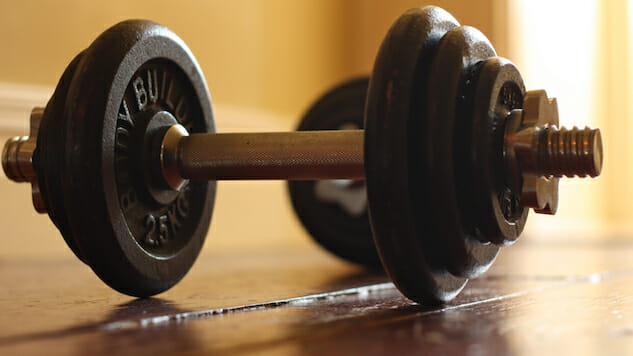
Let’s be honest, when it comes to skipping a workout, the number-one reason people give for avoiding the gym is time.
But what if I told you there’s a workout that requires less time to perform and still burns the same amount of calories as if you were going on a 40-minute run or bike ride?
Sound too good to be true? Guess again.
New research from North Dakota State University has shown promising results that burning a higher number of calories in a shorter amount of time is possible.
Jake Erickson, who was a graduate assistant at NDSU at the time of the study, looked at rest periods and volume loads. He wanted to figure out what was more important for a higher-calorie burn: the weight someone used or the rest interval between their sets.
Erickson set up six different strength exercises performed with intervals at a 2:1 work to rest ratio. He had participants do three sets of each exercise before moving onto the next move and the entire circuit took roughly 13 minutes and 45 seconds to complete.
What he found was that when you give your body less time to recover between bursts of intense physical activity, you’re actually able to burn a lot more calories. These results from NDSU revealed that participants who performed this circuit burned 346 calories on average in just 13 minutes.
The Workout
The following workout is the one Erickson used with the participants in the study. He stresses the importance of minimizing rest, while not worrying about the weight so much. In other words, this is not the workout for pushing heavy weight.
Participants chose a weight that was 50% of their one-rep max, with the idea being: a lighter load goes a longer way. However, if done properly, that load should feel much heavier than 50% of your one-rep max by the time you get to your third and final round of a particular exercise.
The 13-Minute Calorie Crusher
Erickson used the following six exercises with the participants in the study: bench press, bent-over row, bicep curl, lying tricep extension, leg extension, and lying leg curl.
The key here is to perform as many reps as possible (AMRAP) of the first exercise in 30 seconds, using a weight that is 50 percent of your one-rep max. After your first set (30 seconds), rest for 15 seconds, then repeat the same exercise two more times with the same 2:1 ratio. Repeat this same format with the remaining exercises.
Example:
175-pound male
Bench press @115 pounds—Perform AMRAP for 30 sec., rest for 15 sec.
Bench press @115 pounds—Perform AMRAP for 30 sec., rest for 15 sec.
Bench press @115 pounds—Perform AMRAP for 30 sec., rest for 15 sec.
Bent-over row @ 95 pounds—Perform AMRAP for 30 sec., rest for 15 sec.
Bent-over row @ 95 pounds—Perform AMRAP for 30 sec., rest for 15 sec.
Bent-over row @ 95 pounds—Perform AMRAP for 30 sec., rest for 15 sec.
Bicep curl @ 40 pounds—Perform AMRAP for 30 sec., rest for 15 sec.
Bicep curl @ 40 pounds—Perform AMRAP for 30 sec., rest for 15 sec.
Bicep curl @ 40 pounds—Perform AMRAP for 30 sec., rest for 15 sec.
Tricep ext. @ 70 pounds—Perform AMRAP for 30 sec., rest for 15 sec.
Tricep ext. @ 70 pounds—Perform AMRAP for 30 sec., rest for 15 sec.
Tricep ext. @ 70 pounds—Perform AMRAP for 30 sec. rest for 15 sec.
Leg ext. @ 80 pounds—Perform AMRAP for 30 sec., rest for 15 sec.
Leg ext. @ 80 pounds—Perform AMRAP for 30 sec., rest for 15 sec.
Leg ext. @ 80 pounds—Perform AMRAP for 30 sec., rest for 15 sec.
Leg curl @ 45 pounds—Perform AMRAP for 30 sec., rest for 15 sec.
Leg curl @ 45 pounds—Perform AMRAP for 30 sec., rest for 15 sec.
Leg curl @ 45 pounds—Perform AMRAP for 30 sec., rest for 15 sec.
Some of the key points to remember about this workout:
1. It is a 2:1 ratio: 30 seconds for each exercise with a 15-second rest in between sets. In other words, do as many repetitions as you can of bench press in 30 seconds, rest for 15 seconds and then perform the exercise again for another 30 seconds.
2. You should be doing about 12-17 reps in a 30-second interval.
3. Make sure your form is correct. Sine you are doing as many reps as possible at a controlled pace, working the muscles in their full range of motion is essential. Again, this is not about heavy weight, as much as it is about continuous movement.
4. Focus should be more on the shorter rest interval, not the weight. The goal is to get a lot of activity in rather than a lot of sitting around, which happens more often when lifting heavy weights.
5. You use up more energy (calories) when you give your body less time to recover between bouts of intense effort.
Image: andy wagstaffe, CC-BY
Sara Lindberg is a freelance writer specializing in health, fitness and wellness.